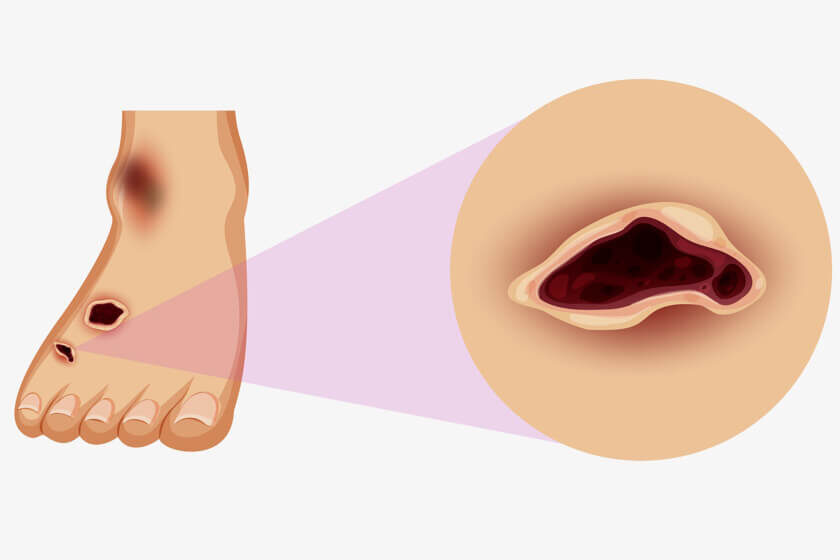Arterial ulcers are one of the most challenging forms of chronic wounds. Caused by poor blood circulation, they often appear on the lower legs, feet, or toes and can lead to severe complications if left untreated. Traditionally, patients had to rely on frequent hospital visits for wound management and monitoring. But with the rise of telehealth care, people struggling with arterial ulcers can now access expert guidance, timely treatment, and continuous monitoring from the comfort of their homes.
In this blog, we’ll explore what arterial ulcers are, how to differentiate them from other wounds, available treatment options, and how telehealth is transforming wound care for better outcomes.
What Are Arterial Ulcers?
Arterial ulcers are open sores that develop due to insufficient blood supply to the tissues. When arteries are narrowed or blocked because of conditions like atherosclerosis, oxygen and nutrients fail to reach the skin, causing tissue death and ulcer formation. These wounds are often extremely painful, particularly at night or when the legs are elevated.
If ignored, arterial ulcers can progress to infections, gangrene, or even amputation. Early identification and treatment are therefore essential.
Common Arterial Ulcers Symptoms
Recognizing arterial ulcers symptoms is the first step toward timely care. Some of the most common signs include:
- Painful sores on the feet, toes, heels, or outer ankle.
- Cool or cold skin in the affected area.
- A wound with a “punched-out” appearance and well-defined edges.
- Shiny, tight, or hairless skin around the ulcer.
- Sluggish or absent pulse in the foot.
- Delayed healing or non-healing wounds despite basic care.
If you notice these signs, it’s crucial to consult a wound care specialist immediately.
Arterial vs. Venous Ulcers: Knowing the Difference
One of the most common confusions in wound care is distinguishing Arterial vs. Venous Ulcers. While both affect the legs, their causes and treatment approaches differ significantly:
- Arterial Ulcers: Result from poor arterial circulation, typically painful, often located on toes, feet, or heels. Edges are well-defined, and skin around may appear shiny or cold.
- Venous Ulcers: Caused by improper venous return, usually less painful, found around the ankles or lower legs. Edges are irregular, and surrounding skin may be discolored or swollen.
Understanding this distinction is vital because the treatment strategies vary. Incorrect management can worsen the wound and delay recovery.
Arterial Ulcer Treatment Options
Effective arterial ulcer treatment requires a combination of medical management, lifestyle changes, and wound care. Some common approaches include:
- Restoring Blood Flow — Procedures like angioplasty or bypass surgery may be recommended to improve circulation.
- Medications — Doctors may prescribe blood thinners, cholesterol-lowering drugs, or pain management medications.
- Wound Care — Specialized dressings, debridement (removal of dead tissue), and infection control measures are critical.
- Lifestyle Modifications — Quitting smoking, eating a balanced diet, and regular exercise help in long-term management.
- Monitoring & Follow-ups — Regular checkups are needed to ensure the ulcer is healing properly and complications are prevented.
The Role of Telehealth in Arterial Ulcer Treatment
Thanks to advancements in technology, telehealth has revolutionized how chronic wounds like arterial ulcers are managed. Here’s how it helps:
1. Remote Consultations
Patients no longer need to travel long distances for every checkup. Through telehealth platforms like WoundGuide.org, individuals can connect with wound care specialists online and receive expert guidance instantly.
2. Continuous Monitoring
Using smartphone cameras and telehealth apps, patients can share pictures of their ulcers with doctors, allowing them to monitor healing progress without frequent hospital visits.
3. Early Detection of Complications
Since arterial ulcers can deteriorate quickly, telehealth ensures that any infection or worsening symptoms are detected early, preventing severe outcomes.
4. Personalized Care Plans
Every patient’s condition is different. Telehealth enables wound care experts to design tailored treatment strategies that consider the patient’s lifestyle, health status, and wound severity.
5. Cost-Effective and Accessible
For patients in rural or underserved areas, telehealth bridges the gap by providing specialized care without the burden of travel and hospitalization costs.
Why Choose Wound Guide for Telehealth Wound Care?
Wound Guide is India’s First Wound Care Helpline, providing specialized telehealth consultations for a wide range of wounds including arterial ulcers, diabetic foot ulcers, venous ulcers, pressure ulcers, infected wounds, and pediatric wounds.
With a team of wound care specialists, Wound Guide ensures:
- Timely assessment of wounds.
- Expert advice for home-based care.
- Monitoring of healing progress.
- Guidance on advanced treatment options.
For anyone struggling with non-healing or painful wounds, Wound Guide offers reliable and compassionate support right at your fingertips.
Final Thoughts
Arterial ulcers are serious wounds that require immediate attention and proper management. With telehealth care, patients can now access expert consultations, personalized treatment plans, and continuous monitoring without the hassle of frequent hospital visits.
Whether you’re dealing with early arterial ulcers symptoms, seeking guidance on arterial ulcer treatment, or wanting to understand arterial vs. venous ulcers, telehealth platforms like WoundGuide.org are making quality wound care more accessible and effective.





Comments